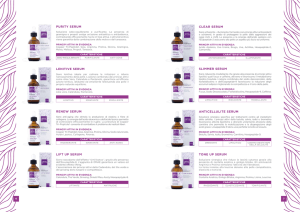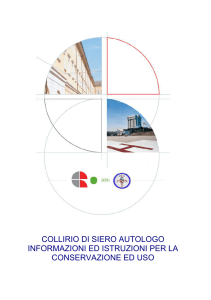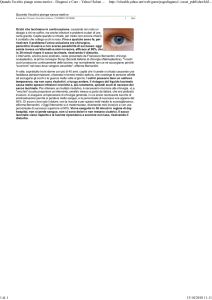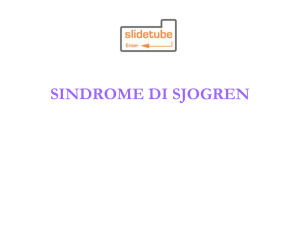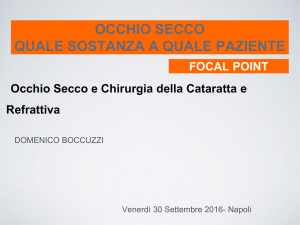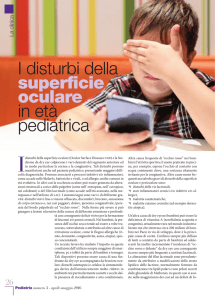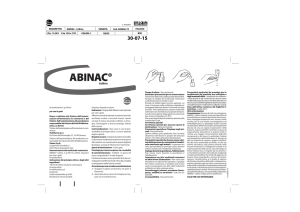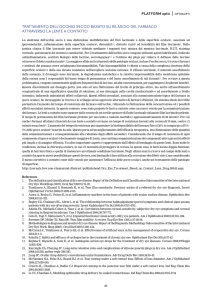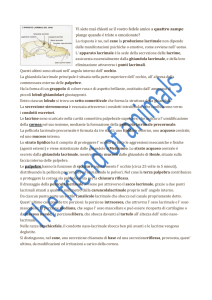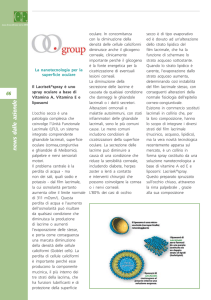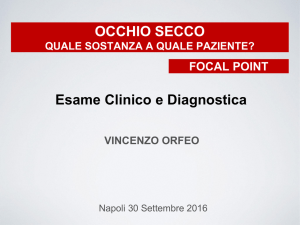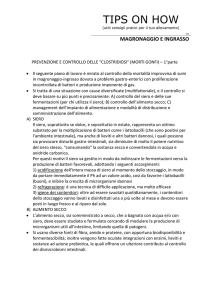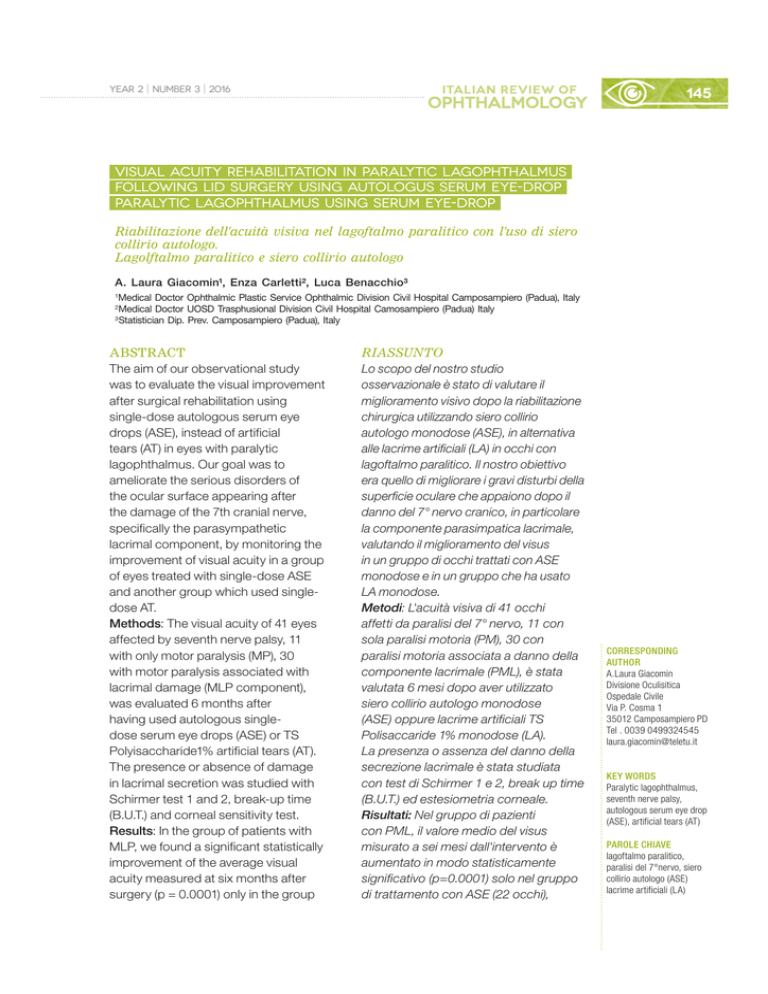
Year 2 ı Number 3 ı 2016
145
VISUAL ACUITY REHABILITATION IN PARALYTIC LAGOPHTHALMUS
FOLLOWING LID SURGERY USING AUTOLOGUS SERUM EYE-DROP
PARALYTIC LAGOPHTHALMUS USING SERUM EYE-DROP
Riabilitazione dell'acuità visiva nel lagoftalmo paralitico con l'uso di siero
collirio autologo.
Lagolftalmo paralitico e siero collirio autologo
A. Laura Giacomin¹, Enza Carletti², Luca Benacchio³
1
Medical Doctor Ophthalmic Plastic Service Ophthalmic Division Civil Hospital Camposampiero (Padua), Italy
Medical Doctor UOSD Trasphusional Division Civil Hospital Camosampiero (Padua) Italy
3
Statistician Dip. Prev. Camposampiero (Padua), Italy
2
ABSTRACT
The aim of our observational study
was to evaluate the visual improvement
after surgical rehabilitation using
single-dose autologous serum eye
drops (ASE), instead of artificial
tears (AT) in eyes with paralytic
lagophthalmus. Our goal was to
ameliorate the serious disorders of
the ocular surface appearing after
the damage of the 7th cranial nerve,
specifically the parasympathetic
lacrimal component, by monitoring the
improvement of visual acuity in a group
of eyes treated with single-dose ASE
and another group which used singledose AT.
Methods: The visual acuity of 41 eyes
affected by seventh nerve palsy, 11
with only motor paralysis (MP), 30
with motor paralysis associated with
lacrimal damage (MLP component),
was evaluated 6 months after
having used autologous singledose serum eye drops (ASE) or TS
Polyisaccharide1% artificial tears (AT).
The presence or absence of damage
in lacrimal secretion was studied with
Schirmer test 1 and 2, break-up time
(B.U.T.) and corneal sensitivity test.
Results: In the group of patients with
MLP, we found a significant statistically
improvement of the average visual
acuity measured at six months after
surgery (p = 0.0001) only in the group
RIASSUNTO
Lo scopo del nostro studio
osservazionale è stato di valutare il
miglioramento visivo dopo la riabilitazione
chirurgica utilizzando siero collirio
autologo monodose (ASE), in alternativa
alle lacrime artificiali (LA) in occhi con
lagoftalmo paralitico. Il nostro obiettivo
era quello di migliorare i gravi disturbi della
superficie oculare che appaiono dopo il
danno del 7° nervo cranico, in particolare
la componente parasimpatica lacrimale,
valutando il miglioramento del visus
in un gruppo di occhi trattati con ASE
monodose e in un gruppo che ha usato
LA monodose.
Metodi: L'acuità visiva di 41 occhi
affetti da paralisi del 7° nervo, 11 con
sola paralisi motoria (PM), 30 con
paralisi motoria associata a danno della
componente lacrimale (PML), è stata
valutata 6 mesi dopo aver utilizzato
siero collirio autologo monodose
(ASE) oppure lacrime artificiali TS
Polisaccaride 1% monodose (LA).
La presenza o assenza del danno della
secrezione lacrimale è stata studiata
con test di Schirmer 1 e 2, break up time
(B.U.T.) ed estesiometria corneale.
Risultati: Nel gruppo di pazienti
con PML, il valore medio del visus
misurato a sei mesi dall'intervento è
aumentato in modo statisticamente
significativo (p=0.0001) solo nel gruppo
di trattamento con ASE (22 occhi),
CORRESPONDING
AUTHOR
A.Laura Giacomin
Divisione Oculisitica
Ospedale Civile
Via P. Cosma 1
35012 Camposampiero PD
Tel . 0039 0499324545
[email protected]
KEY WORDS
Paralytic lagophthalmus,
seventh nerve palsy,
autologous serum eye drop
(ASE), artificial tears (AT)
PAROLE CHIAVE
lagoftalmo paralitico,
paralisi del 7°nervo, siero
collirio autologo (ASE)
lacrime artificiali (LA)
146
Visual Acuity Rehabilitation in Paralytic Lagophthalmus following Lid Surgery using Autologus Serum Eye-Drop
Paralytic Lagophthalmus using Serum Eye-Drop
with ASE (22 eyes); conversely the
eyes treated with AT didn't show any
significant improvement (8 eyes).
Six months after the surgery there was
a statistically significant improvement in
visual acuity in the MP group
(p = 0.0500) and ASE treated eyes
(7 eyes). The AT treated eyes didn't
show any significant improvement at all
(4 eyes).
Conclusions: Autologous serum eye
drop should be used as a substitute of
natural tears especially with patients
affected by severe disorders of the
ocular surface, because most of the
factors that promote corneal epithelial
regeneration (epidermal growth factor
and nerve growth factor) are found both
in tears and serum.
These particular components may
stimulate the lacrimal gland and
conjunctival lacrimal cells to restore
their function, improving tear secretion,
restoring dry eye, corneal transparency
and visual acuity.
INTRODUCTION
The paralysis of the seventh nerve
due to peripheral nerve damage, has
a complex impact on the health and
quality of life of the affected patients.
The deformity of the face is severely
limiting in personal relationships, and
it also causes a loss of important
physiological functions such as
chewing, hearing and sight.
Lagophthalmus in peripheral nerve
damage of the 7th is a serious condition
for the equilibrium of the ocular surface
of the affected eye.
The loss or reduction of the normal
blinking determines an abnormal
distribution of the tear film. Moreover
chronic meibomian gland phlogosis
present in lagophthalmus also causes
an alteration in the lipid portion of the
tears.
non ha invece mostrato un incremento
significativo negli occhi trattati con LA
(8 occhi).
Nel gruppo di pazienti con PM, il
miglioramento del visus a sei mesi
dall'intervento è risultato ai limiti della
significatività statistica (p=0.0500) negli
occhi trattati con ASE (7 occhi) e non
significativo nel gruppo trattato con LA
(4 occhi).
Conclusioni: è opportuno usare ASE
come sostituto di lacrime naturali
in particolare in pazienti con gravi
disturbi della superficie oculare,
perché la maggior parte dei fattori che
promuovono la rigenerazione epiteliale
corneale (Epidermal Growth Factor e il
fattore di crescita nervosa) si trovano sia
nelle lacrime che nel siero.
Questi componenti particolari possono
stimolare la ghiandola lacrimale e le
cellule congiuntivali lacrimali a ripristinare
la loro funzione, migliorare la secrezione
lacrimale, correggere la secchezza
oculare, la trasparenza corneale e l'acuità
visiva.
INTRODUZIONE
La paralisi del settimo nervo, secondaria
a un danno periferico, ha un impatto
complesso sulla salute e qualità di vita dei
pazienti che ne sono colpiti.
Il dismorfismo del volto è fortemente
limitante nei rapporti personali e, inoltre,
induce un danno di importanti funzioni
fisiologiche come la masticazione, l'udito
e la vista.
Il lagoftalmo nel danno periferico del
7° nervo è una condizione grave per
l'equilibrio della superficie oculare
dell'occhio colpito.
La perdita o la riduzione del normale
ammiccamento determina una
distribuzione anomala del film lacrimale.
La meibomite cronica presente nel
lagoftalmo induce, inoltre, un'alterazione
della parte lipidica delle lacrime.
Year 2 ı Number 3 ı 2016
147
Riabilitazione dell'acuità visiva nel lagoftalmo paralitico con l'uso di siero collirio autologo
Lagolftalmo paralitico e siero collirio autologo
The atonic orbicularis muscle doesn't
squeeze the tears in the lacrimal
drainage apparatus thus inducing
epiphora.
Moreover, if the visceral
parasympathetic component
(Wrisberg nerve) is damaged there is
an interruption of the normal arc eye
defence reflex, in which the fifth nerve
(afferent branch from the cornea) and
the seventh nerve (efferent branch from
the lacrimal gland) are involved, with
serious ocular surface disorders and
visual acuity reduction.
The tear fluid, with its three components
(mucus, lipids and water) is essential
for the preservation of sight and any
change in its qualitative or quantitative
composition have a great impact on
visual acuity.
A good tear meniscus on the cornea
is necessary for the tropism of
the epithelium, as well as for the
maintenance of corneal transparency.
A dry eye causes various side effects on
the ocular surface as hyperosmolarity,
activation of metal-proteases and
inflammation.
Patients who suffer from severe corneal
epithelial disorders usually do not have
enough tears to support the tropism of
the corneal epithelium.
Thus, the decrease of corneal sensitivity
reflecting the fifth nerve functionality, not
only indicates damage to the trigeminal
nerve, but also the extent of the blinking
rarity22.
For many years, partial or total
tarsorraphy has been performed
on eyes presenting a low corneal
sensitivity in order to avoid neurotrophic
keratopathy or corneal perforation.
This procedure, which is never well
accepted by the patient, today can
be temporarily performed waiting to
make and obtain a static lid reanimation
surgery and a lacrimal revival using
Il muscolo orbicolare atonico non spreme
le lacrime nell'apparato di drenaggio
lacrimale inducendo così l'epifora.
Inoltre, se la componente parasimpatica
viscerale è danneggiata (nervo di
Wrisberg), si interrompe il normale arco
riflesso dell'occhio in cui sono coinvolti il
quinto nervo (ramo afferente dalla cornea)
e settimo ramo (efferente dalla ghiandola
lacrimale), con gravi disturbi della
superficie oculare e riduzione dell'acuità
visiva.
Il fluido lacrimale con le sue tre componenti
(muco, lipidi e acqua) è fondamentale per
la conservazione della vista ed eventuali
variazioni nella composizione qualitativa
o quantitativa hanno un grande impatto
sull'acuità visiva.
Un buon menisco lacrimale sulla cornea
è necessario per il trofismo dell'epitelio,
nonché per il mantenimento della
trasparenza corneale. Un occhio secco
provoca vari effetti collaterali sulla
superficie oculare come iperosmolarità,
attivazione delle metallo-proteasi e
l'infiammazione.
I pazienti che hanno gravi disturbi epiteliali
corneali di solito non hanno lacrime
sufficienti per sostenere il trofismo
dell'epitelio corneale.
Pertanto la diminuzione della sensibilità
corneale, che riflette la funzionalità del
5° nervo, non indica solo un danno al
trigemino ma anche l'entità della rarità
dell'ammiccamento22.
Per anni la tarsorrafia parziale o totale è
stata eseguita sugli occhi che avevano
una bassa sensibilità corneale per
evitare una cheratopatia neurotrofica o la
perforazione della cornea.
Questa procedura, che non è mai ben
accettata dal paziente, oggi può essere
eseguita per un periodo temporaneo
in attesa di eseguire ed ottenere una
riabilitazione palpebrale statica e lacrimale
attraverso la chirurgia e l'uso del siero
collirio autologo (ASE).
148
Visual Acuity Rehabilitation in Paralytic Lagophthalmus following Lid Surgery using Autologus Serum Eye-Drop
Paralytic Lagophthalmus using Serum Eye-Drop
autologous serum eye drops (ASE).
The idea of using ASE as a substitute
to natural tears is based on the on
the presence of most of the epithelial
growth factors both in the tears and in
the serum.
The serum is obtained from autologous
whole blood and contains Epidermal
Growth Factor (EGF), Nerve Growth
Factor (NGF) and other components able
to stimulate the lacrimal gland and the
lacrimal conjunctival cells in order to restore
their function and improve tear secretion
especially in its aqueous component.
The aim of our observational study was
to evaluate the visual improvement after
surgical rehabilitation and the use of
ASE instead of artificial tears.
PATHOPHYSIOLOGY OF
CORNEAL DAMAGE
The neural regulation of the lacrimal
gland is a complex condition which
involves several stages: first at all, the
activation of the sensory nerves in the
cornea and conjunctiva; secondly,
the stimulation of sympathetic and
parasympathetic efferent nerves; third,
the activation of the acinar and ductal
cells; finally, the secretion of proteins,
electrolytes and water2.
The cornea reacts to an exogenous
or endogenous damage by producing
many substances such as cytokines,
growth factors, neuropeptides and
proteases to restore anatomical integrity
(epithelialization, stromal repair and
re-innervation).
Chronologically, the first event
occurring after damage is the corneal
re-epithelialization by stimulating the
proliferation, migration and differentiation
of the surrounding epithelium.
This process is initiated and controlled
by the release of soluble factors by the
corneal epithelium, by the keratinocytes
and by the lacrimal glands, such as
L'idea di utilizzare ASE come sostituto
alle lacrime naturali è basata sulla
constatazione che la maggior parte dei
fattori di crescita epiteliali si trovano sia
nelle lacrime che nel siero.
Il siero è ottenuto da sangue intero
autologo e contiene Epidermal Growth
Factor (E.G.F.), Nerve Growth Factor
(N.G.F.) e altri componenti in grado di
stimolare la ghiandola lacrimale e le
cellule lacrimali congiuntivali al fine di
ripristinare la loro funzione e migliorare la
secrezione lacrimale soprattutto nella sua
componente acquosa.
Lo scopo del nostro studio
osservazionale è stato di valutare il
miglioramento visivo dopo la riabilitazione
chirurgica e l'utilizzo di ASE rispetto alle
lacrime artificiali.
FISIOPATOLOGIA DEL DANNO
CORNEALE
La regolazione neurale della ghiandola
lacrimale è una condizione complessa
che comporta varie fasi: in primo luogo,
l'attivazione dei nervi sensoriali nella
cornea e congiuntiva; in secondo luogo,
la stimolazione dei nervi simpatico e
parasimpatico efferenti; in terzo luogo,
l'attivazione delle cellule acinose e duttali;
infine, la secrezione di proteine, elettroliti e
acqua2.
La cornea reagisce ad un danno esogeno
o endogeno producendo numerose
sostanze come le citochine, fattori
di crescita, poteasi e neuropeptidi
per ripristinare l'integrità anatomica
(riepitelizzazione, riparazione stromale e
re-innervazione).
Cronologicamente il primo evento
che si verifica dopo un danno è la
riepitelizzazione corneale attraverso
la stimolazione della proliferazione,
migrazione e differenziazione dell'epitelio
circostante. Questo processo viene
avviato e controllato dal rilascio di fattori
solubili da parte dell'epitelio corneale, dei
Year 2 ı Number 3 ı 2016
149
Riabilitazione dell'acuità visiva nel lagoftalmo paralitico con l'uso di siero collirio autologo
Lagolftalmo paralitico e siero collirio autologo
fibronectin, the tumour necrosis factor-ß
(TNF-ß), the cholecystokinin, the
gene-related peptide (CGRP), groups
of the epidermal growth factor type
1, interleukin-6 (IL-6) with stimulatory
effects, the hepatic growth factor (HGF),
and the tumour growth factor (TGF-B)
with inhibitory activity.
A change in the balance between
inhibitory and stimulating factors leads
to the development of complications,
therefore it is essential to get a quick
and accurate re-epithelialization10.
The substances released from the
damaged epithelium do also influence
the stroma, causing an increase in
apoptosis of keratinocytes as well as the
activation and migration of cells and the
collagen fibrils deposit.
A balance between the deposit and the
breakdown of cellular matrix is essential
for the formation of transparent tissue3.
The expression of the type 1 receptors
and growth factor to the epithelium of
the ocular surface suggest that they
may play a role in the homeostasis
and wound repair. On the contrary, the
altered expression of these receptors
can determine the pathogenesis of
ocular surface diseases such as dry
kerato-conjunctivitis4-20.
Although the pH and the osmolarity are
similar in tears and serum, the levels of
fibronectin in natural tears can be of 80
micrograms /ml when the eye is open
and up to 12,000 micrograms /ml when
the eye is closed, compared to 300
micrograms /ml of serum.
The concentration of E.G.F. in natural
tears is included in a range between
0.7 and 10 ng per ml. On the contrary,
the levels of retinol in natural tears and
serum are approximately equal to 10
and 55 ppt/ml respectively11.
The concentration of TGF-ß in the tears
and in serum is respectively of 10 and
50 ng/ml5.
cheratinociti e delle ghiandole lacrimali,
come la fibronectina, il fattore di necrosi
tumorale-ß (TNF-ß), la colecistochinina,
il peptide correlato al gene (CGRP),
gruppi del fattore di crescita epidermico
di tipo 1, l'interleuchina 6 (IL-6) con effetti
stimolatori, il fattore di crescita epatico
(HGF) e il fattore di crescita tumorale
(TGF-B) con attività inibitoria.
Un cambiamento nell'equilibrio tra
fattori inibenti e stimolanti porta allo
sviluppo di complicanze, pertanto è
essenziale ottenere una rapida e corretta
riepitelizzazione10.
Le sostanze rilasciate dall'epitelio
danneggiato influenzano anche lo stroma,
provocando un aumento della apoptosi
dei cheratinociti così come l'attivazione e
la migrazione delle cellule e il deposito di
fibrille di collagene.
Un equilibrio tra il deposito e la
scomposizione della matrice cellulare è
essenziale per la formazione di tessuto
trasparente3.
L'espressione dei recettori di tipo 1 e
del fattore di crescita per l'epitelio della
superficie oculare suggeriscono che essi
possono svolgere un ruolo nell'omeostasi
e nella riparazione delle ferite. Al contrario,
l'espressione alterata di questi recettori
può essere all'origine della patogenesi
delle malattie della superficie oculare,
come la cheratocongiuntivite secca4-20.
Anche se il pH e l'osmolarità sono
simili nelle lacrime e nel siero, i livelli
di fibronectina nelle lacrime naturali
possono avere valori di 80 μg/ml quando
l'occhio è aperto e fino a 12.000 μg/ml
quando l'occhio è chiuso, rispetto ai 300
μg/ml del siero.
La concentrazione di E.G.F. nelle lacrime
naturali è compresa in un range tra
0.7 e 10 ng per ml. Al contrario, i livelli
di retinolo nelle lacrime naturali e nel
siero sono circa pari a 10 e 55 ng/ml
rispettivamente11.
La concentrazione di TGF-ß nelle lacrime
150
Visual Acuity Rehabilitation in Paralytic Lagophthalmus following Lid Surgery using Autologus Serum Eye-Drop
Paralytic Lagophthalmus using Serum Eye-Drop
Since TGF-beta is known to inhibit the
proliferation of epithelial cells, many
ophthalmologists use serum diluted
from 20% to 50%12.
MATERIALS AND METHODS
Between 2012 and 2014, 41 eyes have
been consecutively recruited out of
40 patients with signs and symptoms
of peripheral paralytic lagophthalmus.
One of the subjects, having a bilateral
involvement of paralysis, was recorded
twice (once for each eye).
During the first examination (time 0),
the patients were evaluated for best
correction visual acuity.
Dry eye and neurotrophic keratitis can
be classified and evaluated with several
clinical tests: the quantitative lacrimal
function has been tested with the 1
and 2 Schirmer test, tear film breakup
time (BUT Break Up Time) and corneal
sensibility test using the Cochet-Bonnet
esthesiometer consisting of a nylon
monofilament. The patient is asked
to look straight in front of him and the
filament is directed to several sectors
of the ocular surface. The patient is
asked to report when he notices to be
touched. It is a test which correlates
the length of the wire with the pressure
values applied in the district and felt by
the patient, expressed in g /mm².
The Schirmer test 1 without
anaesthetic measures the basal and
reflex tear secretion, (normal values
under 40 years of age>15 mm; over 40
years of age>10 mm).
A lower value at these levels indicates
a lachrymal hypo secretion which is
balanced by the reflected secretion and
which identifies a dry syndrome. The
basal production is given by the secretion
of conjunctival accessory glands.
Schirmer 1 test was performed, after
drying of the tear stagnant.
Schirmer 2 test with anaesthetic
e nel siero è rispettivamente di 10 e 50
ng/ml5.
Poiché TGF-ß è noto per inibire la
proliferazione delle cellule epiteliali, molti
oftalmologi usano siero diluito dal 20% al
50%12.
MATERIALI E METODI
Tra il 2012 e il 2014, sono stati reclutati
consecutivamente 41 occhi su un totale
di 40 pazienti con segni e sintomi di
lagoftalmo paralitico periferico. Uno dei
soggetti, avendo un lagoftalmo paralitico
con interessamento bilaterale, è stato
registrato due volte (una per ogni occhio).
Durante la prima visita (tempo 0), ai
pazienti è stata valutata l'acuità visiva con
la migliore correzione.
L'occhio secco e la cheratite neurotrofica
possono essere classificati e valutati da
diversi test clinici: la funzione lacrimale è
stato testata con il test di Schirmer 1e 2,
il tempo di rottura del film lacrimale
(Break Up Time B.U.T.) e il test
di sensibilità corneale utilizzando
l'estesiometro Cochet-Bonnet costituito
da un monofilamento di nylon. Il paziente
viene invitato a guardare diritto e il
filamento viene indirizzato su vari settori
della superficie oculare. ll paziente è
invitato a riferire quando avverte di
essere toccato. È un test che correla la
lunghezza del filo con i valori di pressione
applicata nel distretto ed avvertita dal
paziente, espressi in gr/mm2.
Lo Schirmer test 1 senza anestetico
misura la secrezione lacrimale basale e
riflessa, (valori normali sotto i 40 anni di
età >15 mm; oltre 40 anni di età >10 mm).
Un valore inferiore a questi livelli indica
una iposecrezione lacrimale poco o nulla
compensata dalla secrezione riflessa
e identifica una sindrome secca. La
produzione basale è data dalla secrezione
delle ghiandole accessorie congiuntivali.
Il test di Schirmer 1 è stato eseguito previa
asciugatura della lacrima ristagnante.
Year 2 ı Number 3 ı 2016
151
Riabilitazione dell'acuità visiva nel lagoftalmo paralitico con l'uso di siero collirio autologo
Lagolftalmo paralitico e siero collirio autologo
measures reflected tear production by
the main lacrimal gland (normal values
under 40 years of age 10 mm, over 40
years of age approximately 5 mm).
The Break-Up Time is a qualitative test
and tear break-up time indicates the tear
film break up (normal value 10 seconds
or more).
The data for the current diagnosis were
detected as well as ongoing and former
ocular therapies, systemic diseases and
all medications in use.
The patients were informed about the
anti-cholinergic effects of certain drugs
such as phenothiazines, antihistamines,
tricyclic antidepressants and atropine,
which were all suspended when taken.
Diuretics such as furosemide, which
inhibits the transport of Na+ K+ 2Cl(an enzyme responsible for the secretion
of chlorine capable of inducing side
effects as dry eye) have also been
suspended.
All patients underwent an electromyogramme (E.M.G.) after two months
since the paralysis in order to stage the
neurological condition and guide the
timing of surgical rehabilitation.
All patients were subjected to the same
surgical therapy (weight eyelid from 1
to 1.8 g, lateral cantopessy, conchal
cartilage implant in the lower eyelid) but
subsequently treated with two therapies:
1) artificial tears, AT (TS Polysaccharide
1% single dose eye drops ),
2) autologous serum eye drops, ASE.
According to the observational nature
of the study the choice of treating
the eye with ASE or AT has not been
randomized: the eyes that presented
a corneal-lagophthalmus damage and
a still present tear secretion (> 5 mm
the Schirmer 1 & 2 test) underwent the
therapy with artificial tears (AT group);
the eyes affected by corneal damage,
lagophthalmus and a low tear secretion
(<5 mm to Schirmer Test 1 & 2) and
Lo Schirmer test 2 con anestetico misura
la produzione di lacrime riflessa ove
interviene principalmente la ghiandola
lacrimale principale (valori normali sotto i
40 anni di età 10 mm, oltre 40 anni di età
5 millimetri circa).
Il Break Up Time è un test lacrimale
qualitativo e indica il tempo di rottura
del film lacrimale (valore normale 10
secondi o più).
Sono stati rilevati i dati relativi alla
diagnosi attuale, le terapie oculari in atto e
precedenti, le malattie sistemiche e tutti i
farmaci in uso.
I pazienti sono stati informati circa
gli effetti anti-colinergici di alcuni
farmaci quali fenotiazine, antistaminici,
antidepressivi triciclici e atropina, che
sono stati tutti sospesi se assunti. Sono
stati sospesi anche i diuretici come
furosemide, che inibisce il trasportatore
di Na+ K+ 2Cl- (un enzima responsabile
della secrezione di cloro in grado di
indurre come effetto collaterale occhio
secco).
Tutti i pazienti sono stati sottoposti a
un elettro-miogramma (E.M.G.) dopo
due mesi dalla paralisi per stadiare la
condizione neurologica e guidare i tempi
della riabilitazione chirurgica.
Tutti i pazienti sono stati sottoposti
a uguale terapia chirurgica (peso
palpebrale da 1 a 1.8 g, cantopessia
laterale, impianto di cartilagine concale
nella palpebra inferiore) ma trattati
successivamente con due terapie:
1) lacrime artificiali, LA (TS Polisaccaride
1% collirio monodose),
2) siero collirio autologo, ASE.
In accordo alla natura osservazionale
dello studio la scelta di trattare l'occhio
con ASE o LA non è stata randomizzata:
gli occhi che hanno presentato un
danno corneale-lagoftalmo e secrezione
lacrimale ancora presente (> 5 millimetri
allo Schirmer 1 & 2 test) hanno seguito la
terapia con lacrime artificiali (gruppo LA);
152
Visual Acuity Rehabilitation in Paralytic Lagophthalmus following Lid Surgery using Autologus Serum Eye-Drop
Paralytic Lagophthalmus using Serum Eye-Drop
obvious reduction in corneal sensitivity
were treated with ASE (ASE group)
All eyes had been suffering from
peripheral paralytic lagophthalmus for
less than 8 months and some of them
were showing a paralysis without the
involvement of the Wrisberg nerve
(only motor paralysis, MP) while other
presented a paralysis with Wrisberg
nerve (motor and tear paralysis, MLP)
involvement.
The evaluation of rehabilitation, as
improvement of visual acuity, was
carried out after a period of 6 months
(time 1)
Before the surgery all patients were
asked to sign the informed consent.
BLOOD PROCEDURE
Patients enrolled by the
ophthalmologist undergo a series of
blood tests and instrumental exams
to assess their suitability to the
procedure. Subsequently they go to
the donor centre with the serology test
results (HIV, HCV, HBV, anti-syphilis),
with the outcome of a complete blood
count, ECG and chest X-ray. After a
medical evaluation and signing the
informed consent, about 300 ml of the
patient's autologous whole blood is
collected in a quadruple bag, deprived
of the anticoagulant.
The collected blood is allowed to rest
for 1 hour at room temperature and
at least 24 hours in the blood bank
at 4° C in a vertical position. The bag
is then centrifuged at 3958 RCF to
complete the squeezing of the clot.
The serum is transferred to a satellite
bag which is then connected to a kit
for the preparation of eye drops serum
aliquots. All operations are carried
out using a sterile connector, working
under a laminar flow hood.
The serum is slowly drained from the
bag to the tube. Multiple unit dose
gli occhi colpiti da danno corneale,
lagoftalmo e una secrezione lacrimale
bassa (<5 millimetri a Schirmer 1 & 2 Test)
ed evidente riduzione della sensibilità
corneale sono stati trattati con ASE.
Tutti gli occhi erano affetti da lagoftalmo
paralitico di tipo periferico da meno di
8 mesi; alcuni occhi presentavano una
paralisi senza interessamento del nervo
di Wrisberg (paralisi solo motoria, PM);
altri occhi presentavano una paralisi con
interessamento del nervo di Wrisberg
(paralisi motoria e lacrimale, PML).
La valutazione della riabilitazione, come
miglioramento del visus, è stata effettuata
dopo un periodo di sei mesi (tempo 1).
Prima dell'intervento a tutti i pazienti
è stato richiesto di firmare il consenso
informato.
PROCEDURE EMATOLOGICHE
I pazienti arruolati dall'oftalmologo
vengono sottoposti ad una serie di esami
ematochimici e strumentali per valutare
la loro idoneità alla procedura prevista.
Successivamente essi si presentano al
Centro Trasfusionale con i risultati dei test
di sierologia (HIV, HCV, HBV, anti-sifilide),
con l'esito di un emocromo, ECG e
radiografia del torace. Dopo la valutazione
medica e la firma del consenso informato,
i pazienti donano circa 300 ml di sangue
intero autologo che viene raccolto in una
sacca quadrupla, priva di anticoagulante.
Il sangue raccolto viene lasciato riposare
per un'ora a temperatura ambiente e
almeno ventiquattro ore in emoteca a
4° C in posizione verticale. La sacca
viene quindi centrifugata a 3958 RCF per
completare la spremitura del coagulo.
Il siero è trasferito in una sacca satellite
successivamente collegata ad un kit
apposito per la preparazione di aliquote
di siero collirio. Tutte le operazioni sono
effettuate utilizzando un connettore
sterile, lavorando sotto cappa a flusso
laminare.
Year 2 ı Number 3 ı 2016
153
Riabilitazione dell'acuità visiva nel lagoftalmo paralitico con l'uso di siero collirio autologo
Lagolftalmo paralitico e siero collirio autologo
containers serum are obtained from
the main pipe by welding at several
points and then separating the
obtained segments. These are then
placed in larger sterile bags, labelled
and finally placed in rigid containers,
on which the tag validation of the
product and that of assignment to the
patient. Is placed the product thus
packaged at -40 °C1.
Part of the material is sent for sterility
testing. The single dose eye drops
serum described above is delivered
only after obtaining a negative
result from the sterility tests. The
patient receives a package with the
single-dose serum to be applied at
home with written instructions and
prescriptions (4 times a day for 6
months). The serum eye- drops are
kept refrigerated (deep frost) for 1
month.
STATISTIC ANALYSIS
The categorical variables have been
described using frequencies and
percentages, whereas continuous
variables were averaged with their
95% confidence interval, and standard
deviation.
In order to verify the association
between categorical variables
the Chi-square test of Pearson or,
if not applicable, the Fisher exact test
was used.
The average differences of variables
among unpaired groups have been
assessed with the Student's t test for
two samples or with the non-parametric
Wilcoxon test for two samples (Wilcoxon
rank-sum test).
For the comparison of the visual acuity
(outcome variable) between the two
detection times and for each therapeutic
approach (AT, ASE) the Student t test for
paired data was used or (in the event of
non-normal distribution of the data ), the
Il siero viene drenato lentamente nel tubo
dalla sacca. Molteplici contenitori di siero
monodose vengono ottenuti dal tubo
principale saldando in più punti e poi
separando i segmenti ottenuti. Questi
vengono poi posti in sacchetti sterili più
grandi, etichettati ed infine in contenitori
rigidi, sui quali è posta l'etichetta di
validazione del prodotto e quella di
assegnazione al paziente. Il prodotto
così confezionato è congelato a -40 °C1.
Parte del materiale è inviato per i test
di sterilità. Il siero collirio monodose
sopra descritto, viene consegnato solo
dopo aver ottenuto un risultato negativo
del test di sterilità. Il paziente riceve
una confezione per uso domestico
con il siero monodose con specifiche
istruzioni scritte e la prescrizione di
instillarlo nell'occhio con lagoftalmo 4
volte al dì per sei mesi. Le gocce oculari
di siero possono essere conservate nel
congelatore di casa per un mese.
ANALISI STATISTICA
Le variabili categoriali sono state
descritte mediante frequenze assolute
e percentuali, mentre per le variabili
continue è stata calcolata la media con il
relativo l'intervallo di confidenza al 95%
e la deviazione standard.
Per la verifica dell'associazione tra
variabili categoriali è stato utilizzato il test
del Chi-quadrato di Pearson o, se non
applicabile, il test esatto di Fisher.
Le differenze di medie di variabili tra
gruppi non appaiati sono state valutate
mediante test t di Student per due
campioni o con il test non parametrico
di Wilcoxon per due campioni (Wilcoxon
rank-sum test).
Per il confronto del visus (variabile di
outcome) tra i due tempi di rilevazione e
per ogni approccio terapeutico (LA, ASE)
è stato utilizzato il test t di Student per dati
appaiati, o (nel caso di distribuzione non
normale dei dati), il test non parametrico
154
Visual Acuity Rehabilitation in Paralytic Lagophthalmus following Lid Surgery using Autologus Serum Eye-Drop
Paralytic Lagophthalmus using Serum Eye-Drop
Tab.
1
Eyes distribution (%) in regard to treatment and type of paralysis
(Pearson's chi-squared test) - Distribuzione degli occhi rispetto al trattamento e al tipo di
paralisi (Chi-quadrato di Pearson test)
Treatment
Trattamento
AT
(n=12)
ASE
(n=29)
Total
(n=41)
MLP
8
(26,6)
22
(73,3)
30
(100.0)
MP
4
(36.4)
7
(63.6)
11
(100.0)
P Value
0.5450
non-parametric Wilcoxon signed rank
test (Wilcoxon matched-pairs signedranks). We analyze separately in relation
to the type of paralysis (MP or MLP).
The assumption of normality of the data
was assessed through tests for normality
(Shapiro-Wilk), skewness and kurtosis.
A p-value value <0.05 was considered
significant.
The statistical analysis was performed
using the program Stata 14.0 (Stata
Corporation, College Station, TX, United
States).
dei ranghi segnati di Wilcoxon (Wilcoxon
matched-pairs signed-ranks). Le analisi
sono state condotte separatamente in
relazione al tipo di paralisi (PM o PML).
L'assunzione di normalità dei dati è stata
esaminata attraverso i test di normalità
(Shapiro-Wilk), di asimmetria e di curtosi.
È stato considerato significativo un
valore p-value<0.05.
L'analisi statistica è stata effettuata
utilizzando il programma Stata 14.0
(Stata Corporation, College Station, Tx,
Stati Uniti d'America).
RESULTS
40 patients, 50% males and 50%
females were recruited, with an
average age of 59.2 years (I.C. 95%:
53.1 to 65.2).
The eyes treated with AT were 12,
while those treated with ASE were
29; 11 eyes had a peripheral paralysis
without the involvement of the Wrisberg
nerve (MP), 30 eyes showed motor
and tear paralysis (MLP). There was no
evident association between the type
of paralysis and the assigned type of
therapy (p = 0.5450) (Table 1).
RISULTATI
Sono stati reclutati 40 pazienti, 50%
maschi e 50% femmine, con un'età
media di 59,2 anni (I.C. 95%: 53,1-65,2).
Gli occhi trattati con LA sono stati
complessivamente 12 e mentre quelli
trattati con ASE sono stati 29; 11 occhi
presentavano una paralisi periferica
senza interessamento del nervo di
Wrisberg (PM), 30 occhi presentavano
paralisi motoria e lacrimale (PML).
Non è stata evidenziata associazione
tra il tipo di paralisi e il tipo di terapia
assegnata (p=0,5450) (Tab.1).
Year 2 ı Number 3 ı 2016
155
Riabilitazione dell'acuità visiva nel lagoftalmo paralitico con l'uso di siero collirio autologo
Lagolftalmo paralitico e siero collirio autologo
Tab.
2
Mean patients' age values (± sd) in regard to treatment (Wilcoxon rank-sum test),
according to the type of paralysis - Valori medi (± ds) dell'età dei pazienti rispetto al
trattamento (Wilcoxon rank-sum test), per tipo di paralisi
Treatment
Trattamento
AT
(n=12)
ASE
(n=29)
Total
(n=41)
P Value
MLP
51.5
±19.8
56.2
±19.8
54.9
±19.6
0.4381
MP
66.8
±22.2
69.0
±10.4
68.2
±14.6
0.8501
No statistically significant difference
was detected in the medium of the
patient's age between the two types of
therapy, separately for the two types of
paralysis (Table 2).
In the eyes with MLP (Fig. 1) the
increase in the average visual acuity
was not statistically significant in the
AT group (p = 0.34449), while it was
statistically significant in the ASE group
(p = 0.0000). In the eyes with MP (Fig.
2) the increase of the average visual
acuity between the two detection times
is not statistically significant in the AT
group (p = 0.1615), whereas it was on
the edge of the significance in the ASE
group (p = 0.0500).
Non è stata evidenziata alcuna
differenza statisticamente significativa
nelle età medie dei pazienti tra i due tipi
di terapia, separatamente per i due tipi
di paralisi (Tab. 2).
Negli occhi con PML (Fig. 1) l'aumento
della media del visus non è risultato
statisticamente significativo nel gruppo
LA ( p=0,34449), mentre è risultato
statisticamente significativo nel gruppo
ASE (p=0,0000). Negli occhi con PM
(Fig. 2) l'aumento della media del
visus tra i due tempi di rilevazione non
è risultata statisticamente significativa
nel gruppo LA (p=0,1615), mentre è
risultata ai limiti della significatività nel
gruppo ASE (p=0,0500).
DISCUSSION
The goal in the rehabilitation of patients
suffering from paralytic lagophthalmus
is to achieve an eyelid closure sufficient
enough to protect the cornea and
effective tear film distribution.
However, static eyelid rehabilitation
surgery alone6-7-8 is never sufficient
or effective enough to restore the
previous visual acuity. The rarity of blink
DISCUSSIONE
L'obiettivo nella riabilitazione dei pazienti
affetti da lagoftalmo paralitico è di
conseguire una chiusura palpebrale
sufficiente a proteggere la cornea ed
efficace a distribuire il film lacrimale.
Tuttavia i soli interventi chirurgici di
riabilitazione palpebrale statica6-7-8 non
sono mai sufficienti o abbastanza efficaci
156
Visual Acuity Rehabilitation in Paralytic Lagophthalmus following Lid Surgery using Autologus Serum Eye-Drop
Paralytic Lagophthalmus using Serum Eye-Drop
Fig. 1
Fig. 1
Comparison of the average
visual acuity values at
baseline (time 0) and 6
months period (time 1) in
regard to the treatment
(Wilcoxon matched-pairs
signed-ranks), MLP
Confronto dei valori medi
del visus al tempo 0 e a
6 mesi (tempo 1) rispetto
al trattamento (Wilcoxon
matched-pairs signedranks), PML
induced by the paralysis causes an
abnormal distribution of the tear film,
an abundant or absent tear meniscus
and orbicularis muscle contraction
defect with partial or complete upper
lachrymal pump failure. The tear film
represents the first and essential
part of the ocular dioptre system. An
abnormal tear distribution or quality
gravely modify visual acuity.
In case of a seventh nerve peripheral
paralysis the first thing to determine is
whether the process is supranuclear
or infranuclear because of different
tearing patterns. Patients with seventh
nerve peripheral paralysis without tear
component damage, infra nuclear
paralysis (MP), have a secondary
damage of the motor branch of the facial
muscles and eyelid orbicularis muscle.
In these patients the lachrymal function
can be altered by a change in the
evaporation phenomenon, due to rare
and ineffective blinking.
This reduces tear production with an
inadequate distribution of the film,
a ripristinare la pregressa acuità visiva.
La rarità dell'ammiccamento che la
paralisi induce comporta un'anomala
distribuzione del film lacrimale, un
abbondante o assente menisco
lacrimale e un deficit di spremitura
dell'orbicolare con blocco più o meno
totale della pompa lacrimale alta. Questo
compromette fortemente il visus essendo
il film lacrimale il primo diottro oculare
indispensabile per una buona visione.
Un'anomala quantità o qualità lacrimale è
già sufficiente a compromettere il visus.
Di fronte ad una paralisi periferica del
nervo facciale la prima cosa da stabilire è
se il processo sia sopra o infra nucleare
per una diversa ripercussione del
fenomeno sulla lacrimazione.
I pazienti affetti da paralisi periferica del
7° nervo senza danno della componente
lacrimale, a sede infra nucleare (PM),
presentano un danno secondario del
ramo motore dei muscoli facciali e del
muscolo orbicolare palpebrale.
In questi pazienti la funzione lacrimale può
essere danneggiata per un fenomeno
Year 2 ı Number 3 ı 2016
157
Riabilitazione dell'acuità visiva nel lagoftalmo paralitico con l'uso di siero collirio autologo
Lagolftalmo paralitico e siero collirio autologo
Fig. 2
Fig. 2
Comparison of the average
visual acuity values at baseline (time 0) and 6 months
period (time 1) in regard to
the treatment (Wilcoxon
matched-pairs signedranks), MP
Confronto dei valori medi
del visus al tempo 0 e a
6 mesi (tempo 1) rispetto
al trattamento (Wilcoxon
matched-pairs signedranks), PM
inducing corneal damage, often with
hypersensitive dry eye25.
In eyes affected by supranuclear
damage (motor branch and
parasympathetic efferent tear branch
of facial nerve) MLP, there is a motor
impairment and a neurotrophic keratitis
due to dry eye secretive deficit, in
addition to the increased evaporation
and corneal hypoesthesia caused by
reduced blinking rate25.
The seventh nerve parasympathetic
branch innervate the main and
accessory lacrimal glands. The affected
patients have severe dry eye and a
secondary neurotrophic keratitis, with
severe reduction of visual acuity, of
that can get worse resulting in corneal
perforation.
We found these clinical and semiological
aspects in our two eyes groups (MP
and MLP), too. After static eyelid surgical
rehabilitation, there is a reduction of
lagophthalmus and protection of the corneal
surface with more effective blink reflex.
The gravity of keratitis and the degree
di alterata evaporazione, essendo il
problema maggiore un ammiccamento
diradato e con inefficacia parziale o totale.
Questo induce una minore produzione
lacrimale, una inadeguata distribuzione,
una sofferenza corneale, spesso con
iperestesia da occhio secco25.
Al contrario, in occhi affetti da danno
sovra nucleare (ramo motore del
7° e blocco della componente
parasimpatica efferente lacrimale) PML,
vi è una compromissione motoria e
una cheratite neurotrofica per occhio
secco da deficit secretivo, oltre
all'aumentata evaporazione per la rarità
dell'ammiccamento; a questa condizione
si associa per lo più una ipoestesia
corneale, per grave alterazione del riflesso
di ammiccamento25.
Infatti il ramo parasimpatico contenuto nel
7° innerva le ghiandole lacrimali principali
ed accessorie.
Di conseguenza, questi pazienti
manifestano una grave secchezza oculare
e una cheratite neurotrofica secondaria
con grave diminuzione dell'acuità visiva
158
Visual Acuity Rehabilitation in Paralytic Lagophthalmus following Lid Surgery using Autologus Serum Eye-Drop
Paralytic Lagophthalmus using Serum Eye-Drop
of tear deficiency can be studied and
evaluated with various clinical tests.
We performed quantitative (Schirmer
1 and 2) and qualitative (B.U.T.) tests
together with the evaluation of the
corneal sensitivity. The latter is the
expression of fifth nerve integrity and
gets altered in presence of the blinking
reflex impairment and keratitis sicca.
The use of single-dose eye drops
autologous serum ASE improves the dry
eye and neurotrophic keratitis in all eyes
with a low tear production level9-13.
The Break-up time ( normal = 10
seconds or more ) value is the first to
deteriorate in the presence of blinking
rarity induced by paralysis resulting
in increased tear evaporation of the
aqueous component and alteration
of the lipid component of the tear
(hyperseborrhoea or altered secretion).
With regard to physiological change of
the tear film as natural consequence of
ageing, the majority of people over 65
undergo the reduction of tear secretion.
The average age of patients with MLP
was 54.9 (51.5 and 56.2 for AT and ASE
respectively) and of 68.2 in patients
with motor paralysis MP only (66.8
and 69.0 respectively for AT and ASE),
values which result different between
the various types of paralysis but
homogeneous between the assigned
treatment types.
Based on these considerations, a
separate analysis for each of these two
groups was performed in order to limit
confounding effect in the evaluation
of visual acuity improvement at the
end of the rehabilitation period, both
for the different level of severity and
non homogeneity of age present in
the involved eyes with the two types of
paralysis.
From a clinical point of view, all patients
showed an improvement in visual acuity
after six months.
che può arrivare alla perforazione della
cornea.
Anche nei nostri due gruppi di occhi (PM
e PML) abbiamo riscontrato questi aspetti
clinici e semeiologici.
Dopo la riabilitazione chirurgica
palpebrale statica, si ottiene una
riduzione del lagoftalmo e la protezione
della cornea con movimenti di
ammiccamento più efficaci durante il
giorno e soprattutto di notte.
La cheratite e il grado di deficit lacrimale
possono essere studiati e valutati con
diversi test clinici.
Abbiamo eseguito test quantitativi
Schirmer 1° e 2 e qualitativi B.U.T.
e la valutazione della sensibilità
corneale. Quest'ultima oltre ad essere
un'espressione di alterazione del 5°
nervo è alterata anche quando vi sia
una compromissione del riflesso di
ammiccamento e in presenza di cheratite
da occhio secco.
L'uso del siero collirio autologo
monodose ASE migliora l'occhio secco
e la cheratite neurotrofica in tutti gli
occhi con un basso livello di produzione
lacrimale9-13.
Il Break up time, qualitativo con valore
normale 10 secondi o più, è il primo
test ad alterarsi in presenza di rarità
dell'ammiccamento indotta dalla
paralisi con conseguente aumento della
componente acquosa lacrimale per
aumento dell'evaporazione e alterazione
della componente lacrimale lipidica
(iperseborrea o alterata secrezione).
Per quanto riguarda il fisiologico
cambiamento del film lacrimale
quale conseguenza naturale
dell'invecchiamento, la maggior parte
delle persone sopra i 65 anni vanno
incontro a riduzione della secrezione
lacrimale. L'età media dei nostri pazienti è
stata di 54,9 per i pazienti con PML (51.5
e 56.2 per LA e ASE rispettivamente)
e 68,2 per i pazienti con solo paralisi
Year 2 ı Number 3 ı 2016
159
Riabilitazione dell'acuità visiva nel lagoftalmo paralitico con l'uso di siero collirio autologo
Lagolftalmo paralitico e siero collirio autologo
However, the results showed a
statistically significant increase in visual
acuity in patients with MLP treated
with ASE or in more severe cases,
while there was not any statistically
significant increase in the group of eyes
with paralysis MP (if not borderline
significance in treated with ASE).
In lagophthalmus the ocular surface is
chronically damaged. For this reason
it is preferable to choose single-dose
artificial tears without preservatives
because of the special susceptibility of
the corneal epithelium to preservatives
in dry eye syndrome. Recent in vitro
animal model tests have confirmed
that pharmaceutical tear substitutes,
compared to serum, do not maintain the
levels of intracellular ATP and the integrity
of the epithelial cell membrane23.
We chose to use the autologous
serum eye drops as an alternative to
conventional treatment with artificial
tears because of the presence of growth
factors both in tears and serum.
Fox et al., were the first to report the
benefits of autologous serum in dry eye
from the Sjogren's syndrome.
This work has been further supported
by the use of autologous serum in
severe dry eye from other authors13-14-15.
Several biologically active growth factors
and their receptors, responsible for the
maintenance of tissue homeostasis
and wound healing, continue to be
elucidated. For instance, the epidermal
growth factor release rates have been
shown to be significantly lower in eyes
that present ocular surface diseases
(including conjunctivitis, corneal erosion
and corneal ulcers) rather than normal
eyes during the reflex tearing11.
Furthermore, the serum concentration
of NGF was measured in healthy
people, having a slight decrease with
increasing age.
Moreover, NGF has an important role
motoria PM (66.8 e 69.0 per LA e ASE
rispettivamente), valori che risultano
diversi tra i tipi di paralisi ma omogenei tra
i tipi di trattamento assegnato.
In base a queste considerazioni, per
limitare effetti di confondimento in
sede di valutazione del miglioramento
dell'acuità visiva al termine del periodo
di riabilitazione, sia a causa del differente
livello di gravità, sia a causa della
disomogeneità delle età presenti negli
occhi interessati dai due tipi di paralisi,
è stata eseguita un'analisi separata per
ognuno di questi due gruppi.
Da un punto di vista clinico, tutti i pazienti
hanno mostrato un miglioramento del
visus al termine dei sei mesi. Tuttavia i
risultati, se da un lato non hanno mostrato
alcun aumento statisticamente rilevante
nel gruppo di occhi con paralisi PM (se
non ai limiti della significatività nei trattati
con ASE), dall'altro, evidenziano un
incremento statisticamente significativo
del visus nei pazienti con PML trattati con
ASE, ovvero nelle situazioni più gravi.
Considerata la cronicizzazione della
malattia della superficie oculare presente
nel lagoftalmo è preferibile scegliere
lacrime artificiali monodose prive di
conservanti a cui l'epitelio corneale
mostra particolare suscettibilità nella
sindrome dell'occhio secco.
Recenti test in vitro in modello animale
hanno confermato che sostituti lacrimali
farmaceutici, rispetto al siero, non
mantengono i livelli di ATP intracellulari
e l'integrità della membrana delle cellule
epiteliali23.
La scelta di utilizzare il siero collirio
autologo in alternativa al trattamento
convenzionale con sole lacrime artificiali,
è stata la presenza dei fattori di crescita
sia nelle lacrime che nel siero. Fox e
collaboratori, per primi riferiscono i
benefici del siero autologo nell'occhio
secco che si ha nella sindrome di Sjögren.
Questo lavoro è stato ulteriormente
160
Visual Acuity Rehabilitation in Paralytic Lagophthalmus following Lid Surgery using Autologus Serum Eye-Drop
Paralytic Lagophthalmus using Serum Eye-Drop
in the development of the sensory and
sympathetic nervous system.
It is indeed an agent that controls
the interaction between the target
tissue and its nervous supply during
its development. For this reason,
embryonic sympathetic and sensory
neurons depend on NGF for survival
and growth.
This dependence of developing neurons
on NGF has been elucidated with the
use of antibodies to NGF, both in vitro
and in vivo. In addition to a trophic
effect, NGF can also exert a chemotactic influence17-19.
Although not specific to the lachrymal
gland function, an alteration of the
sensitivity of corneal nerves can cause
dry eye by partly blocking lachrymal
glands proteins, electrolytes and water
secretion2.
A decrease of corneal sensory nerves
can occur with ageing and diabetes.
This reduction in sensitivity can induce
a decrease in lachrymal gland secretion
while in dry eye conditions there is an
increase in the corneal sensitivity22.
In case of seventh nerve paralysis there
is a reduction of the corneal sensitivity,
despite of a dry eye, for a blink reflex
reduction25.
The autologous serum eye drops
are a blood component and must
be produced by the Transfusion
Centre according to existing rules and
regulations. The criteria for patient
selection is the same which is applied to
autologous blood donation, with further
exclusion of those positive for hepatitis
B, hepatitis C, syphilis, HIV undergoing
an anticoagulant therapy. The patient
obviously does not show any evidence
of acute infection, and Haemoglobin
and Hematocrit levels should not be
inferior to 11g/dl and 33%.
In the last years, there has been an
increasing use of blood components
sostenuto dall'uso del siero autologo
nella secchezza oculare grave da altri
autori13-14-15.
Il ruolo di numerosi fattori di crescita,
biologicamente attivi nel mantenimento
dell'omeostasi tissutale e la guarigione
delle ferite, debbono ancora essere
chiariti. Per esempio, negli occhi che
presentano malattie della superficie
oculare (compresa congiuntivite,
erosione corneale e ulcere corneali) è
stato evidenziato che i tassi di rilascio
di fattore di crescita epidermico è
significativamente inferiore rispetto
agli occhi normali durante il riflesso di
lacrimazione11.
Inoltre la concentrazione sierica di NGF
è stata misurata in persone sane e ha
una leggera diminuzione col progredire
dell'età.
L'NGF ha anche un ruolo importante nello
sviluppo del sistema nervoso sensoriale
e simpatico. È infatti una sostanza
che regola l'interazione tra il tessuto
bersaglio e il suo supporto nervoso
durante lo sviluppo. Per questo motivo i
neuroni simpatici e sensoriali embrionali
dipendono dal NGF per la sopravvivenza
e la crescita. Questa dipendenza dei
neuroni in fase di sviluppo dal NGF è
stata chiarita con l'uso di anticorpi per
l'NGF, sia in vitro che in vivo. Oltre ad un
effetto trofico, l'NGF può esercitare anche
un'influenza chemio-tattica17-19.
Anche se non è uno stimolo specifico
per la funzione della ghiandola lacrimale,
un'alterazione della sensibilità dei nervi
corneali può causare secchezza oculare,
bloccando in parte la produzione di
proteine lacrimali, elettroliti e la secrezione
di acqua2.
Una diminuzione dei nervi sensoriali
corneali può verificarsi con
l'invecchiamento ed il diabete.
Questa riduzione di sensibilità può
indurre una diminuzione della secrezione
della ghiandola lacrimale mentre in
Year 2 ı Number 3 ı 2016
161
Riabilitazione dell'acuità visiva nel lagoftalmo paralitico con l'uso di siero collirio autologo
Lagolftalmo paralitico e siero collirio autologo
for topical use (fibrin glue, gel platelets,
serum eye drops) and for some
the process can be automated
(Fibrin in glue).
A working group for the standardization
of these components has been formed.
A greater guarantee of the
hemocomponent sterility is provided by
the choice to use a closed system and by
the production of a single dose eye drops.
The current legislation, with the
publication of the Decree 02/11/2015
G.U. n. 69: "Provisions relating to the
requirements of quality and safety of
blood and blood components", has
considered the production of blood
products for topical use by regulating
the production1-16.
Patients with a discrete preservation
of the watery tear secretion are not
suitable candidates for ASE treatment.
This complex procedure often
requires family assistance and optimal
preservation of the drops which limits
the patient's mobility.
However, ASE therapy secondary to
facial paralysis is a great opportunity
for all kinds of lagophthalmus since
lachrymal gland production can change
and restore itself. This represents a new
therapeutic opportunity in patients with
more severe facial damage especially if
age is below 65 years.
When the afferent branch of tear reflex
mediated by the fifth nerve has been
damaged in association to a damage
of the efferent branch mediated by the
seventh nerve, therapy with ASE is
ineffective and other therapies (such
as amniotic membrane application,
partial tarsorraphy or trigeminal nerve
transplantation) must be evaluated for
each specific case19-21.
Our observational results cannot
guarantee any certainty about the future
visual outcome of the eye affected by
facial paralysis.
condizioni di secchezza oculare vi è un
aumento della sensibilità corneale22.
Nella condizione di paralisi del 7° nervo
vi è una riduzione della sensibilità
corneale nonostante vi sia un occhio
secco, per una riduzione del riflesso di
ammiccamento25.
Il siero collirio autologo è una
componente del sangue e deve essere
prodotto dal Centro Trasfusionale in
conformità alle normative vigenti.
I criteri per la selezione dei pazienti sono
gli stessi che si applicano alla donazione
di sangue autologo, con l'ulteriore
esclusione di quelli positivi per l'epatite
B, il virus C, la sifilide, HIV o che sono
sottoposti a terapia anticoagulante.
Il paziente ovviamente non deve
evidenziare segni di infezione e i livelli di
emoglobina e di ematocrito non devono
essere inferiori ai 11gr/dl e 33%.
Negli ultimi anni, c'è stato un crescente
utilizzo di componenti del sangue per
uso topico (colla di fibrina, piastrine gel,
siero collirio) e per alcuni di essi vi è la
possibilità di automatizzare il processo
(es. colla di fibrina).
È stato formato un gruppo di lavoro per la
standardizzazione di questi componenti.
La scelta di utilizzare un sistema chiuso
e di produrre un collirio monodose,
fornisce una maggiore garanzia di sterilità
dell'emocomponente.
La normativa vigente, con la
pubblicazione del DL 2/11/2015 G.U.
numero 69: “Disposizioni relative
ai requisiti di qualità e sicurezza del
sangue e degli emocomponenti”, ha
preso in esame anche la produzione
degli emocomponenti per uso topico
regolamentandone la produzione1-16.
I pazienti con una discreta conservazione
della secrezione lacrimale acquosa non
sono candidati idonei per il trattamento
ASE. Questa procedura complessa
richiede spesso l'assistenza familiare e la
conservazione ottimale delle gocce che
162
Visual Acuity Rehabilitation in Paralytic Lagophthalmus following Lid Surgery using Autologus Serum Eye-Drop
Paralytic Lagophthalmus using Serum Eye-Drop
The recovery of motor and lachrymal
function also depends on the etiology
and pathogenesis of paralytic form
which affected the seventh nerve.
However our results can only confirm
the efficacy of autologous serum eye
drops rather than artificial tears in this
variety of dry eye. The possibilities
it offers by reactivating the lacrimal
component of blinking reflex, turning a
dry eye in a copious tearing eye, due to
its "growth factors", make the serum an
effective and innovative instrument, and
an additional treatment option for this
serious and disabling condition15-16-17-20.
limita la mobilità del paziente. Tuttavia la
terapia ASE secondaria a paralisi facciale
è una grande opportunità per tutti i tipi
di lagoftalmo poiché può cambiare la
produzione della ghiandola lacrimale
e ripristinarla. Questo rappresenta
una nuova opportunità terapeutica
specialmente nei pazienti con danno del
facciale più grave quando l'età è inferiore
ai 65 anni.
Quando il ramo afferente del riflesso
lacrimale mediato dal 5° nervo è stato
danneggiato in associazione ai danni del
ramo efferente mediato dal 7° nervo, la
terapia con ASE è inefficace e altre terapie
(come l'applicazione della membrana
amniotica, la tarsorrafia parziale o il
trapianto di nervo trigemino) devono
essere valutate e personalizzate nello
specifico caso19-21.
I nostri risultati non possono dare la
certezza sul futuro esito visivo dell'occhio
colpito da paralisi facciale. La ripresa o
meno della funzione motoria e lacrimale
dipende anche dall'eziologia e dalla
patogenesi della forma paralitica che ha
interessato il 7° nervo. Tuttavia essi non
possono che confermare l'efficacia del
siero collirio autologo in questa varietà
di occhio secco rispetto all'utilizzo di
lacrime artificiali. La possibilità che
esso offre nel riattivare la componente
lacrimale del riflesso di ammiccamento
trasformando un occhio secco in un
occhio con abbondante lacrimazione,
grazie ai “growth factors” in esso
contenuti, lo rende un presidio efficace,
innovativo e un'ulteriore opportunità
terapeutica in questa grave e invalidante
patologia15-16-17-20.
Year 2 ı Number 3 ı 2016
163
Riabilitazione dell'acuità visiva nel lagoftalmo paralitico con l'uso di siero collirio autologo
Lagolftalmo paralitico e siero collirio autologo
REFERENCES
1. Yamada C, Ness KE. Autologus serum eye drops:
literature review and implications for transfusion
medicine specialists. Transfusion 2008;48:1245-55
2. Dartt DA. Neural regulation of lacrimal gland
secretory processes: relevance in dry eye
diseases. Progress in Retinal and Eye Research
2009;28(3):155-77
3. Baudouin C. A new approach for better
comprehension of diseases of the ocular surface.
J Fr Ophthalmol 2007 Mar;30(3):239-46
4. Liu Z, Carvajal M, Carothers Carraway CA,
Carraway KL, Pflugfelder SC. Increased expression
of the type 1 growth factor receptor family in
the conjunctival epithelium of patients with
keratoconjunctivite sicca. Am J Ophthalmol 2000
Apr;129(4):472-80
5. Report of the International Dry Eye Workshop
(dews). Gestione e terapia dell'occhio secco:
Rapporto del Sottocomitato Gestione e Terapia
del Workshop Internazionale dell'Occhio Secco
(2007)
6. Krastinova D, Franchi G, Kelly MB, Chabolle F.
Rehabilitation of the paralysed or lax lower eyelid
using a graft of conchal cartilage. Br J Plast Surg
2002 Jan;55(1):12-9
7. Bach CA, Raphael M, Krastinova D. The paralyzed
eyelid: an alternative to gold weight, elevator
palpebrae lengthening. Ann Chir Plast Esthet. 2009
Feb;54(1):37-44. Epub 2008 Oct 19
8. Krastinova D. Treatment of paralytic lagophthalmus
with gold weight implants covered by elevator Apo
neurosis. Ophthal Plast Reconstr Surg 2009 MayJun;25(3):189-93
9. Noble BA, Loh RS, MacLennan S, Pesudovs
K, Reynolds A, Bridges LR, Burr J, Steward O,
Quereshi S. Comparison of autologus serum eyedrops with conventional therapy in a randomised
controlled crossover trial for ocular surface
diseases. Br J Ophthalmol 2004 May;88(5):603-4
10. CLAO J. 2000 Jul; 26(3):159-65 Comment in
CLAO J. 2000 Jul; 26(3):118. Why the eye become
dry: a cornea and lachrymal gland feedback
model.
11. Klenkler B, Sheardown H, Jones L. Growth factors
in the tear film: in tissue maintenance, wound
healing, and ocular pathology. Ocul Surf 2007
July;5(3):228-39
12. Vecchio S, Santilli E, D'ettoris AR, Musuraca V,
Leonardo P, Maltese P, Geremicca W, Schipani G. The
use of platelet-rich plasma for the topical treatment
of corneal lesions. Blood Transfus 2006;4:133-40
13. Fox RI, Chan R, Michelson J, et al. Beneficial
effects of artificial tears made with autologus
serum in patients with keratoconjunctivitis sicca.
Arthritis Rheum 1984;29:577-83
14. Tsubota K, Goto E, Fujuta H, et al. Treatment of dry
eye by autologus serum application in Sïogren's
syndrome. Br J Ophthalmol 1999;83:390-95
15. Poon AC, Geerling G, Dart JKG, et al. Autologus
serum eye drops for dry eye and epithelial defects:
clinical and vitro toxicity studies. Br J Ophtalmol
2001;85:1188-97
16. Tsubota k, Goto E, Shimurra S, et al. Treatment
of persistent epithelial defect by autologus serum
application. Ophthalmology 1999;106:1984-89
17. Ohashi Y, Motokura M, Kinoshita Y, et al. Presence
of epidermal growth factor in human tears. Invest
Ophthalmol Vis Sci 1986;27:1261-68
18. Liu Z, Carvajal M, Carothers Carraway CA,
Carraway KL, Pflugfelder SC. Increased expression
of the type 1 growth factor receptor family in
the conjunctival epithelium of patients with
keratoconjunctivitis sicca. Am J Ophthalmol 2000
Apr;129(4):472-80
19. Rubin LR. The paralyzed face. Chapter 9 pg 67-68
Mosby year book, Inc. 1991
20. López-García JS, García-Lozano I, Rivas L,
Giménez C, Acera A, Suárez-Cortés T. Effects
of Autologous Serum Eye Drops on Conjunctival
Expression of MUC5AC in Patients With Ocular
Surface Disorders. Cornea 2016 Mar;35(3):336-41
21. Terzis JK, Dryer MM, Bodner BI. Corneal
neurotisation: a novel solution to neurotrophic
keratopathy. Plastic and reconstructive surgery
2009 Vol 123;(1):112-20
22. Stolze HH, Volprecht A, Weber U. Significance
of subjective sensitivity in evaluation of
keratoconjunctivitis sicca. Ophthalmologe 1995
Feb;92(1):3-5
23. Poon A, Geerling G, Dart J, Fraenkel G, Daniels
J. Autologous serum eyedrops for dry eyes and
epithelial defects: clinical and in vitro toxicity
studies. Br J Ophthalmol 2001 Oct; 85(10):1188-97.
24. Celebi AR, Ulusoy C, Mirza GE. The efficacy of
autologous serum eye drops for severe dry eye
syndrome: a randomized double-blind crossover
study. Graefes Arch Clin Exp Ophthalmol 2014
Apr;252(4):619-26
25. Liu GT, Volpe NJ, Galetta SL. Neuro-ophtalmology
diagnosis and management. Saunders Elsevier
2010 cap 2 pag. 23

